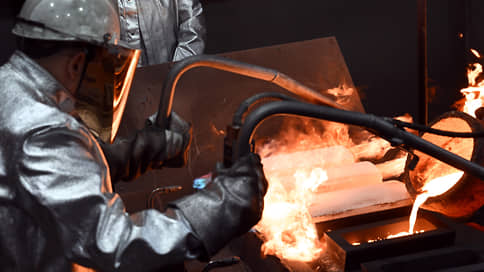Excise tax has hardened on liquid steel
[ad_1]

As Kommersant found out, the Ministry of Finance does not plan to change the parameters of the excise tax on liquid steel until the end of the first quarter of 2024. At the end of September, the ministry announced that it could adjust the excise tax due to the increase in profitability of metallurgists. The companies themselves, according to Kommersant, on the contrary, consider it necessary to increase the cut-off price, above which the excise tax is reset to zero. Analysts believe that an increase in the tax burden on metallurgists is likely if global steel prices continue to strengthen.
“Kommersant” became aware of the main approaches of the relevant ministries to adjustments to the excise tax on liquid steel, which the Ministry of Finance announced at the end of September in the “Main Directions of Budget, Tax and Customs Tariff Policy for 2024–2026.” The document noted that the profitability of metallurgical companies in the first half of the year increased to 37% compared to 12% for the same period a year earlier. Thus, the average price of slab for January-June was $562 per ton compared to $442 in the second half of 2022, steel billet – $564 versus $507, respectively.
According to Kommersant’s sources, the Ministry of Finance does not plan to make adjustments to the excise tax until the end of the first quarter of 2024. The Ministry of Finance officially told Kommersant that there are no plans to adjust the excise tax calculation formula. The metallurgical companies did not comment.
Currently, the excise tax rate is 2.7% of the average monthly export price for steel slabs on an FOB basis. However, if the ruble price of the slab is below 30 thousand rubles. per ton, no excise tax is paid. The ruble cut-off price was introduced in the fall of 2022 at the initiative of metallurgists. Previously, the formula included a dollar price of $300 per ton, and due to the strengthening of the ruble in the summer of 2022, companies were forced to pay excise tax even with a significant drop in world prices. Now the situation is the opposite – the weakening of the ruble has increased the ruble profitability of metallurgists, but, on the other hand, according to Kommersant, companies believe that the cut-off price should be increased, reflecting the weakening of the ruble relative to the level of autumn 2022.
The Ministry of Industry and Trade told Kommersant that the cut-off is 30 thousand rubles. was introduced in 2022 “as a support measure for Russian metallurgists in the context of adapting to unprecedented sanctions pressure from unfriendly countries and reducing the capacity utilization of the main metallurgical plants.” Now the situation is radically different, the ministry said, the workload of metallurgists since the beginning of the year has been consistently over 90%, steel production in January-August increased by 3.7%, by the end of the year an increase of 3.5% is expected, to 74 million tons. “The cost of slab throughout the year has been consistently significantly higher than the established level, currently about $460 per ton, or 44-45 thousand rubles,” the Ministry of Industry and Trade added. They noted that they would take part in elaborating the issue of adjusting the excise tax when specific proposals are received from the Ministry of Finance, “while taking into account the tasks of optimizing the tax burden on the industry, noted in the strategy for the development of the metallurgical industry until 2030, approved by the Russian government.”
Adjusting the excise tax not in favor of metallurgists is a likely option, says independent tax expert Boris Lutset. He draws attention to the fact that due to changes in the exchange rate, the cut-off price in dollar terms has practically returned to the value from which the authorities abandoned last year. At the same time, the Ministry of Industry and Trade and the Ministry of Finance agree on a positive assessment of the situation in metallurgy; in particular, the Ministry of Industry and Trade stated that the current level of profitability of metallurgists makes the excise tax “absolutely high.”
The excise tax on steel is not an excise tax as such, but is aimed at extracting rent, the expert believes. “Further decisions will depend on many factors, primarily on exchange rates, the dynamics of world and domestic steel prices. Export duties tied to it have already been introduced in relation to the exchange rate, so the factor of changes in steel quotations may become decisive,” believes Boris Lutset. He believes that with the rising price environment, a return to a new discussion of tax increases is almost inevitable.
[ad_2]
Source link





